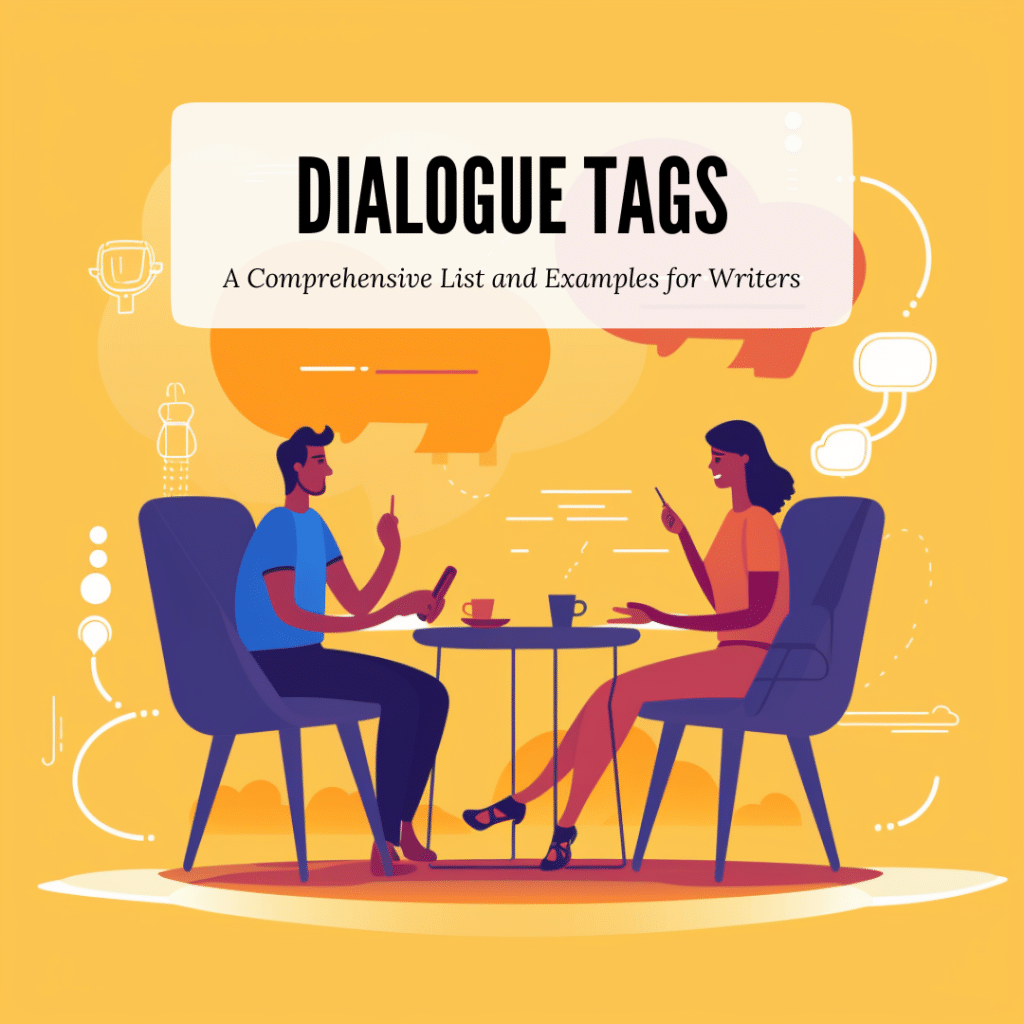The art of writing is more than just stringing words together. It’s about breathing life into characters, giving them unique voices, and setting the tone of a scene within your story. As a writer, you may find yourself constantly searching for new ways to express your characters’ emotions and actions through dialogue. To help you expand your vocabulary and enhance your writing, we’ve created this comprehensive list of dialogue tags, perfect for any writer looking to level up their craft.
But first, let’s dive into the importance of dialogue tags and how they can benefit your writing.

What are Dialogue Tags?
Dialogue tags, also known as speech tags, are phrases used to indicate who is speaking and how they are speaking in a story. These tags are essential for providing clarity, establishing tone, and conveying emotions and actions that may not be apparent from the dialogue alone.
Using a wide range of dialogue tags can enhance your writing and keep it from becoming monotonous. However, it’s important to strike a balance—too many unique tags can be distracting, while too few can leave your reader feeling unengaged.
Now, let’s explore the long list of examples of different types of dialogue tags for writers.
Basic Dialogue Tags
Basic dialogue tags are simple and unobtrusive. They keep the focus on the dialogue itself and are ideal for everyday conversations. Here are some common examples:
- said
- replied
- asked
- answered
Dialogue Tags Indicating Volume
These tags help convey the loudness or quietness of a character’s speech, adding an extra layer of emotion and context to the conversation.
- whispered
- murmured
- muttered
- shouted
- screamed
- bellowed
- hollered
- roared
- hissed
Dialogue Tags Denoting Emotion
Emotional dialogue tags allow you to show how a character is feeling, whether it’s happiness, sadness, anger, or any other emotion.
- laughed
- giggled
- sighed
- sobbed
- cried
- moaned
- snarled
- growled
- sneered
Dialogue Tags Signifying Tone
Tone-based dialogue tags help convey the manner in which a character is speaking, from sarcastic to serious, and everything in between.
- quipped
- retorted
- snapped
- jeered
- taunted
- scolded
- admonished
- lectured
- encouraged
Dialogue Tags Showing Speed and Rhythm
These tags illustrate the speed and rhythm of a character’s speech, providing insight into their thought process and emotional state.
- stammered
- stuttered
- drawled
- rambled
- rushed
- blurted
- mumbled
- droned
- chanted
Dialogue Tags Indicating Action
Action-based dialogue tags help to paint a vivid picture of a character’s movements and gestures, enhancing the overall scene.
- gasped
- panted
- wheezed
- coughed
- choked
- sputtered
- yawned
- hiccupped
- croaked
Dialogue Tags Expressing Confidence or Uncertainty
Use these tags to convey a character’s level of certainty or confidence in their speech.
- asserted
- declared
- proclaimed
- announced
- insisted
- guessed
- wondered
- speculated
- doubted
Dialogue Tags for Relaying Information
These tags are ideal for moments when characters are sharing information or knowledge with one another.
- explained
- elaborated
- informed
- revealed
- disclosed
- divulged
- narrated
- recounted
- described
Dialogue Tags for Questioning and Probing
When characters are inquisitive or seeking answers, use these dialogue tags to emphasize their curiosity.
- inquired
- interrogated
- questioned
- probed
- queried
- pressed
- grilled
- pried
Dialogue Tags for Persuasion and Suggestion
These tags are perfect for showcasing characters’ attempts to persuade, convince, or offer suggestions to others.
- urged
- coaxed
- cajoled
- implored
- begged
- pleaded
- advised
- recommended
- proposed
Dialogue Tags Reflecting Agreement or Disagreement
Use these tags to express a character’s agreement or disagreement with other characters in the story.
- agreed
- concurred
- acknowledged
- consented
- acquiesced
- objected
- protested
- opposed
- disputed
Dialogue Tags for Surprise and Realization
Capture moments of surprise or sudden realizations with these dialogue tags.
- exclaimed
- gasped
- gaped
- blurted
- stammered
- marveled
- realized
- discovered
- deduced
How to Use Dialogue Tags in Your Writing
Overusing unique dialogue tags can be distracting and detract from the overall story. Instead, focus on using the most appropriate tags for each situation and striking a balance between variety and simplicity. Here are some questions to ask yourself that will help you determine if a dialogue tag enhances a scene.
- What is the overall tone of the scene? How would the chosen dialogue tag contribute to building the tone throughout the scene?
- Does the dialogue tag provide additional context or clarification to the reader about the scene or the characters? Is it redundant to something that is already obvious given the dialogue or the context?
- Does the Dialogue Tag distract from the message that the character is sending to the other people in the context?
- Can the reader interpret the sentence with or without the dialogue tag the same way?
By contemplating these questions writers can determine which dialogue tags are appropriate for each situation. In creating a balance between clarity and variety, the dialogue tags will add depth to the writing without overpowering the dialogue.
Conclusion
Having a diverse range of dialogue tags at your disposal can significantly enhance the quality of your writing, making it more engaging and vivid for your readers. By using this comprehensive list of dialogue tags, you can create conversations that convey emotion effectively and paint a clear picture of your characters and their interactions, taking your writing to new heights and creating captivating, immersive stories that will resonate with your readers.